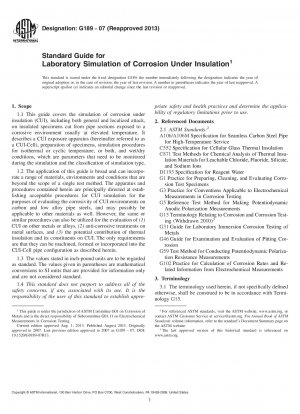ASTM G189-07(2013)
Standard Guide for Laboratory Simulation of Corrosion Under Insulation
- Standard No.
- ASTM G189-07(2013)
- Release Date
- 2007
- Published By
- American Society for Testing and Materials (ASTM)
- Status
- Replace By
- ASTM G189-07(2021)e1
- Latest
- ASTM G189-07(2021)e1
- Scope
5.1 The corrosion observed on steel and other materials under thermal insulation is of great concern for many industries including chemical processing, petroleum refining and electric power generation. In most cases, insulation is utilized on piping and vessels to maintain the temperatures of the operating systems for process stabilization and energy conservation. However, these situations can also provide the prerequisites for the occurrence of general or localized corrosion, or both, and in stainless steels, stress corrosion cracking. For example, combined with elevated temperatures, CUI can sometimes result in aqueous corrosion rates for steel that are greater than those found in conventional immersion tests conducted in either open or closed systems (see Fig. 1).4 This figure shows actual CUI data determined in the field compared with the corrosion data from fully immersed corrosion coupons tests.
5.2 This guide provides a technical basis for laboratory simulation of many of the manifestations of CUI. This is an area where there has been a need for better simulation techniques, but until recently, has eluded many investigators. Much of the available experimental data is based on field and in-plant measurements of remaining wall thickness. Laboratory studies have generally been limited to simple immersion tests for the corrosivity of leachants from thermal insulation on corrosion coupons using techniques similar to those given in Practice G31. The field and inplant tests give an indication of corrosion after the fact and can not be easily utilized for experimental purposes. The use of coupons in laboratory immersion tests can give a general indication of corrosion tendencies. However, in some cases, these procedures are useful in ranking insulative materials in terms of their tendencies to leach corrosive species. However, this immersion technique does not always present an accurate representation of the actual CUI tendencies experienced in the service due to differences in exposure geometry, temperature, cyclic temperatures, or wet/dry conditions in the plant and field environments.
5.3 One of the special aspects of the apparatus and methodologies contained herein are their capabilities to accommodate several aspects critical to successful simulation of the CUI exposure condition. These are: (1) an idealized annular geometry between piping and surrounding thermal insulation, (2) internal heating to produce a hot-wall surface on which CUI can be quantified, (3) introduction of ionic solutions into the annular cavity between the piping and thermal insulation, (4) control of the temperature to produce either isothermal or cyclic temperature conditions, and (5) control of the delivery of the control or solution to produce wet or wet-dry conditions. Other simpler methods can be used to run corrosion evaluations on specimens imme............
ASTM G189-07(2013) Referenced Document
- ASTM A106/A106M Standard Specification for Seamless Carbon Steel Pipe for High-Temperature Service
- ASTM C552 Standard Specification for Cellular Glass Thermal Insulation
- ASTM C871 Standard Test Methods for Chemical Analysis of Thermal Insulation Materials for Leachable Chloride, Fluoride, Silicate, and Sodium Ions
- ASTM D1193 Standard Specification for Reagent Water
- ASTM G1 Standard Practice for Preparing, Cleaning, and Evaluating Corrosion Test Specimens
- ASTM G102 Standard Practice for Calculation of Corrosion Rates and Related Information from Electrochemical Measurements
- ASTM G15 Standard Terminology Relating to Corrosion and Corrosion Testing
- ASTM G3 Standard Practice for Conventions Applicable to Electrochemical Measurements in Corrosion Testing
- ASTM G31 Standard Practice for Laboratory Immersion Corrosion Testing of Metals
- ASTM G46 Standard Guide for Examination and Evaluation of Pitting Corrosion
- ASTM G5 Standard Reference Test Method for Making Potentiostatic and Potentiodynamic Anodic Polarization Measurements
- ASTM G59 Standard Test Method for Conducting Potentiodynamic Polarization Resistance Measurements
ASTM G189-07(2013) history
- 2021 ASTM G189-07(2021)e1 Standard Guide for Laboratory Simulation of Corrosion Under Insulation
- 2007 ASTM G189-07(2013) Standard Guide for Laboratory Simulation of Corrosion Under Insulation
- 2007 ASTM G189-07 Standard Guide for Laboratory Simulation of Corrosion Under Insulation

Copyright ©2024 All Rights Reserved